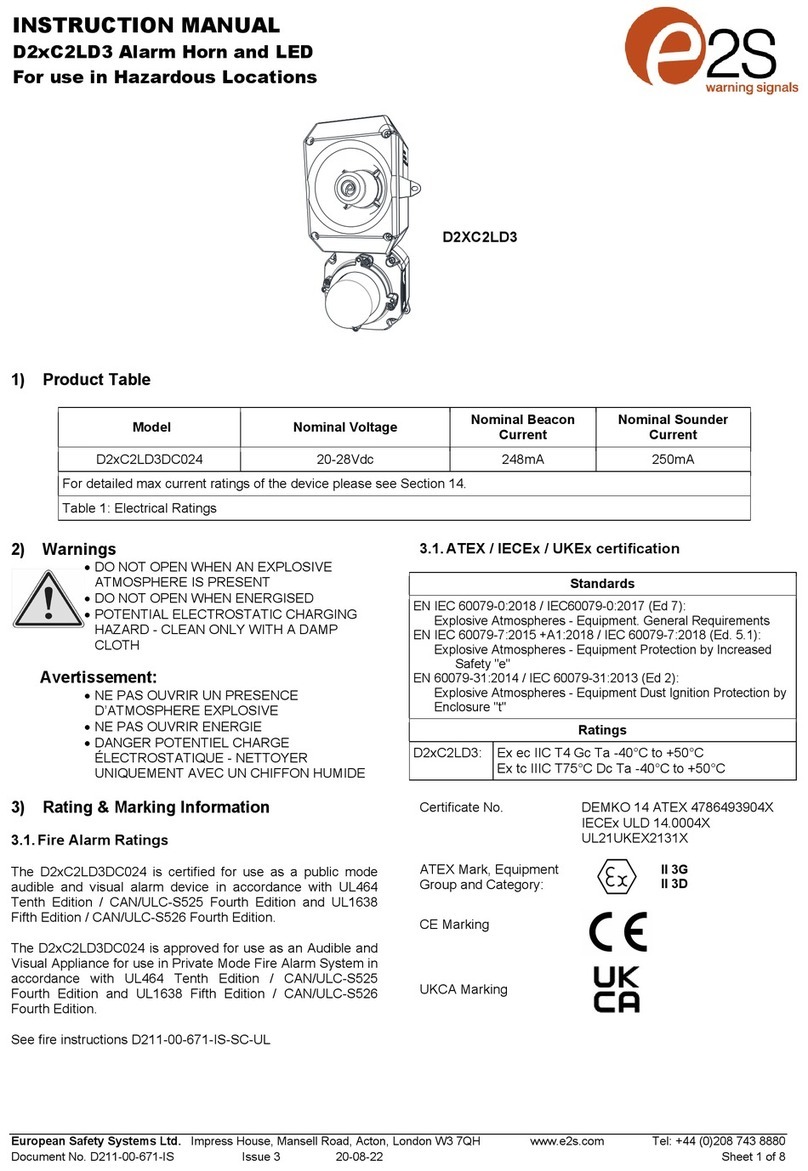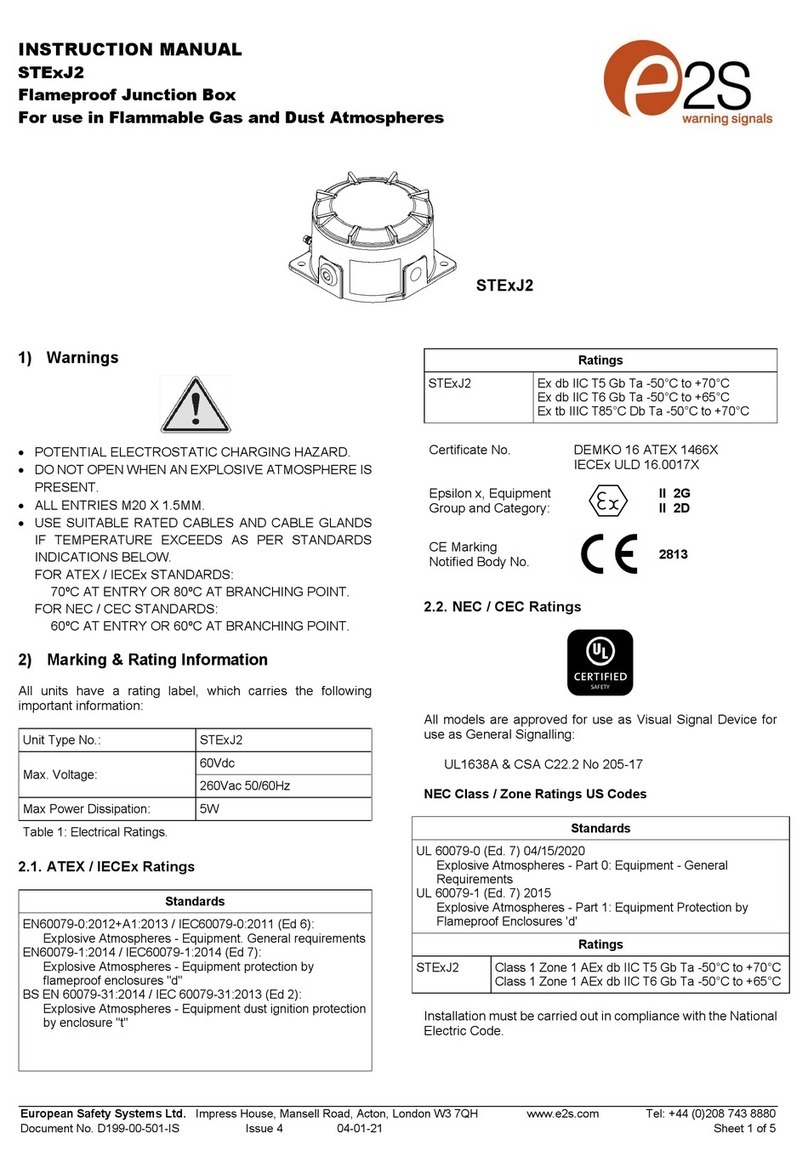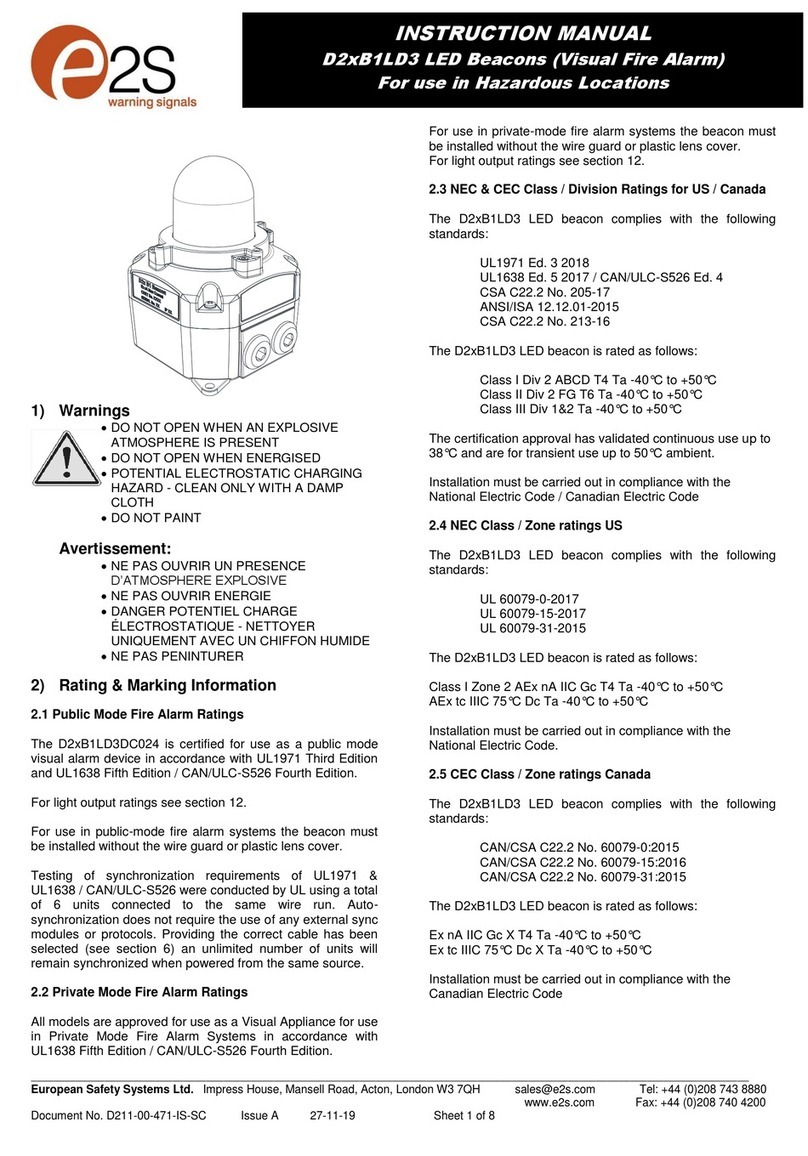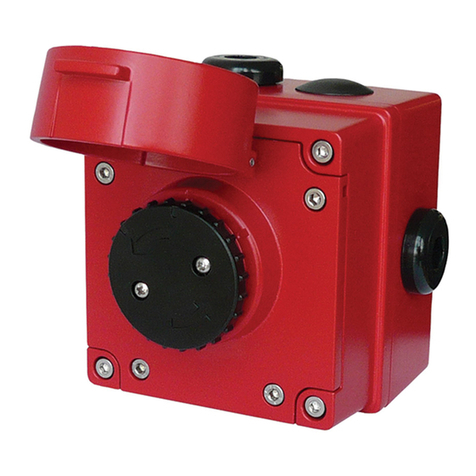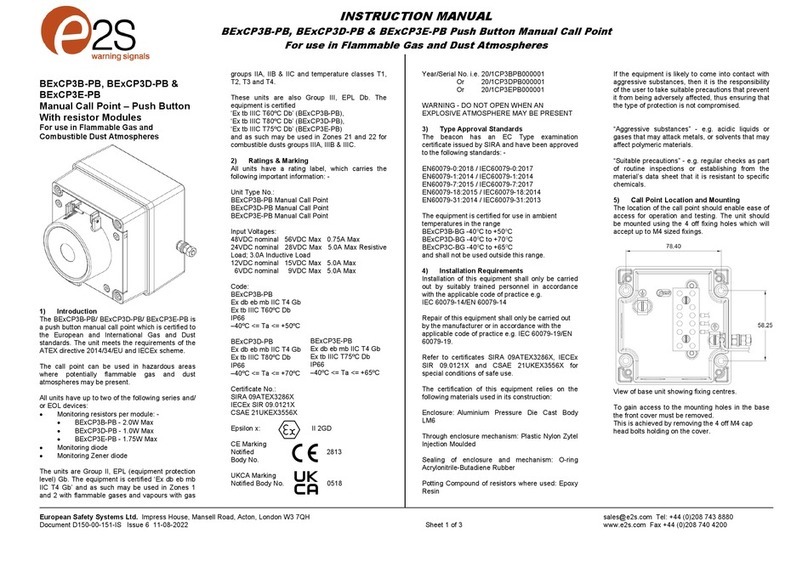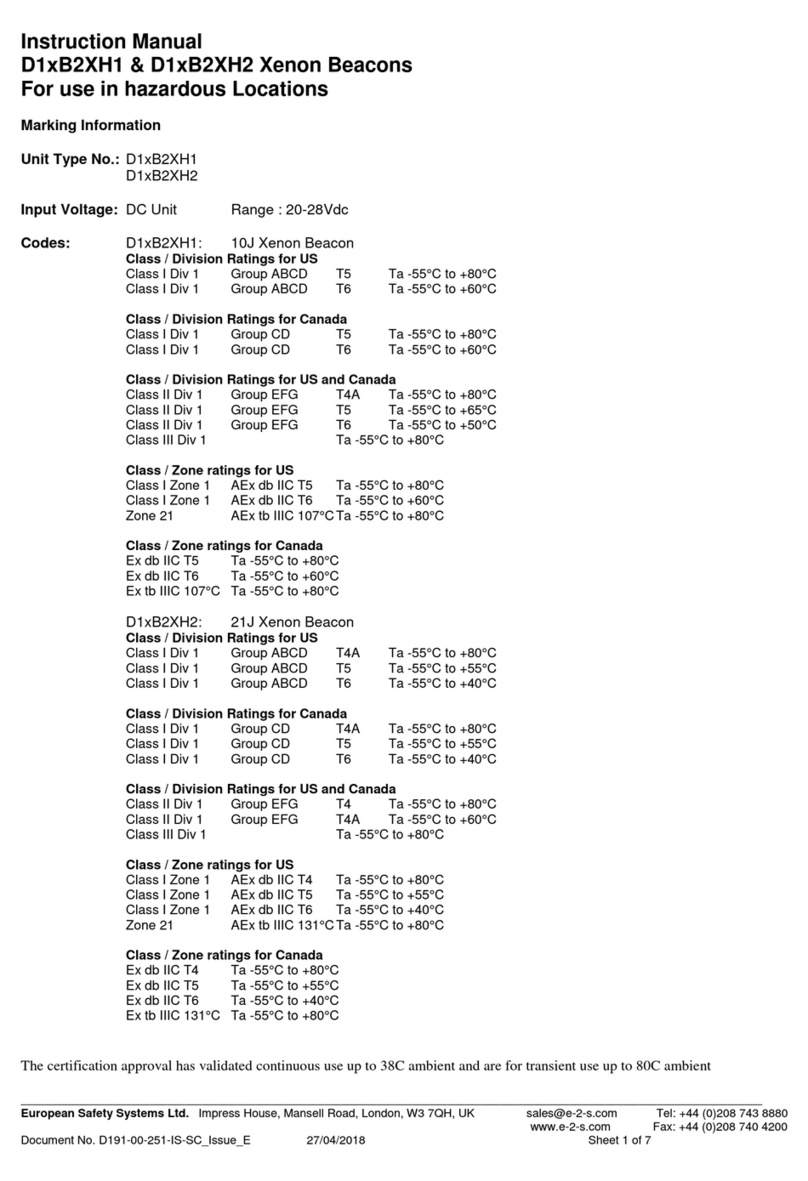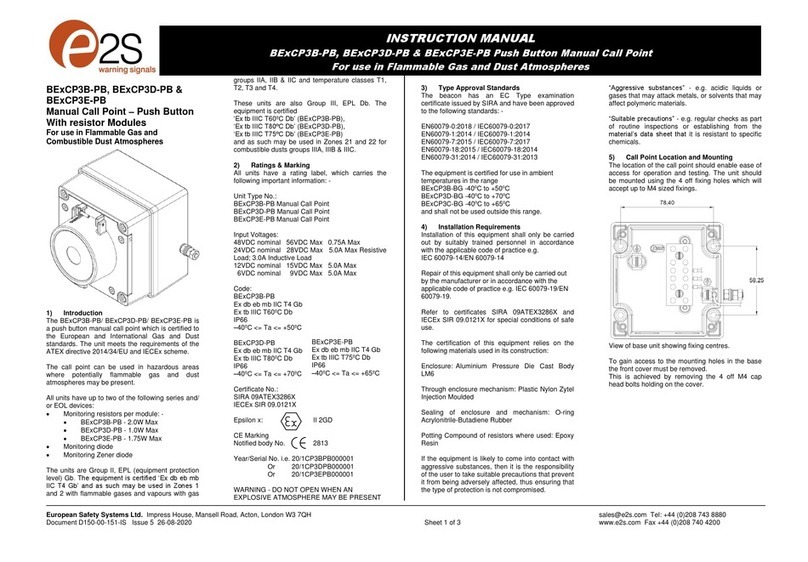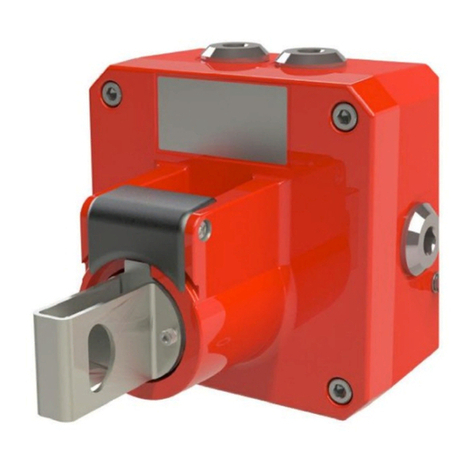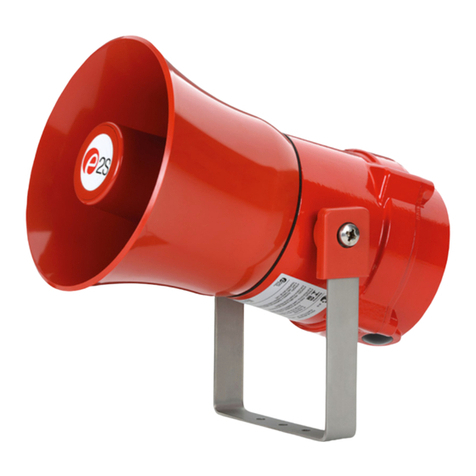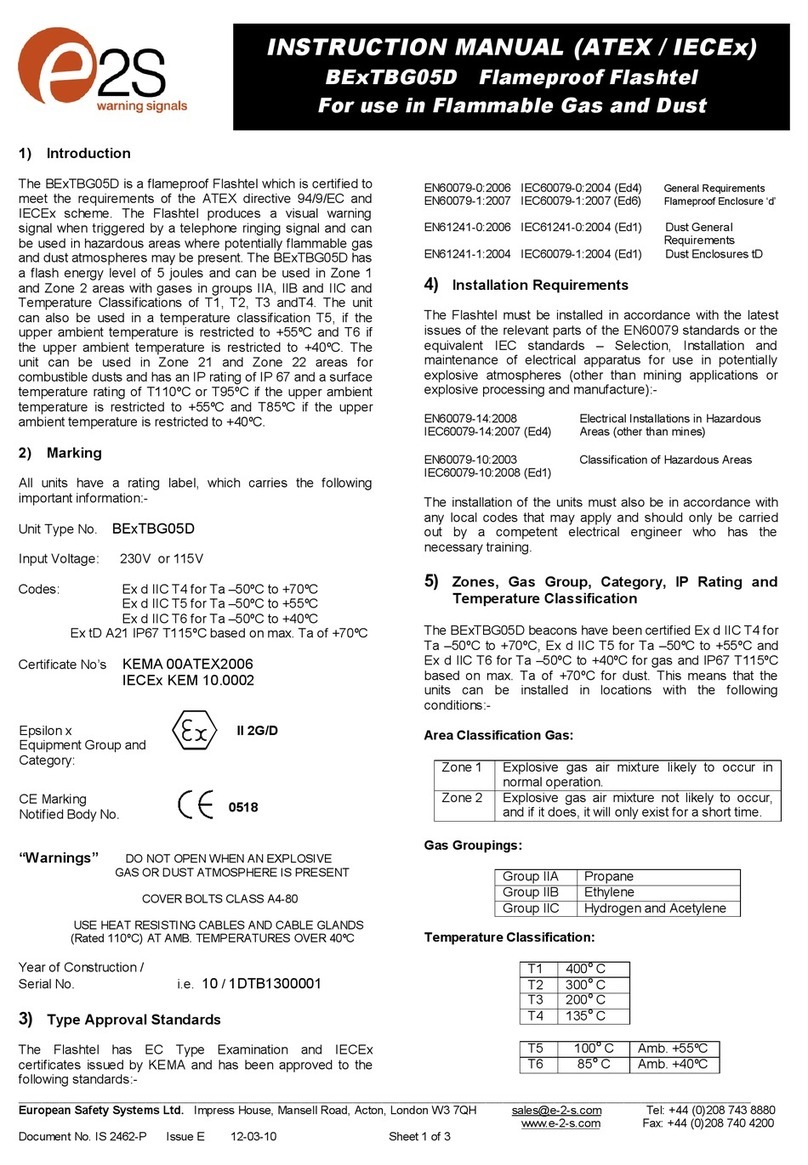European
Safe
ty
System
s
Ltd.
Impress House, Mansell Road, Acton, London W3 7QH [email protected] Tel: +44 (0)208 743 8880 Document D150-00-051-IS Issue 7 26-08-20 Sheet 1 of 3 www.e2s.com Fax +44 (0)208 740 4200
BExCP3B-BG, BExCP3D-BG &
BExCP3E-BG
Manual Call Point –Break Glass
With Resistor Modules
For use in Flammable Gas and
Combustible Dust Atmospheres.
1) Introduction
The BExCP3B-BG / BExCP3D-BG / BExCP3E-BG
is a break glass manual call point which is certified
to the European and International Gas and Dust
standards. The unit meets the requirements of the
ATEX directive 2014/34/EU and IECEx scheme.
The call point can be used in hazardous areas
where potentially flammable gas and dust
atmospheres may be present.
All units have up to two of the following series and/
or EOL devices:
•Monitoring resistors per module: -
•BExCP3B-BG - 2.0W Max
•BExCP3D-BG - 1.0W Max
•BExCP3E-BG - 1.75W Max
•Monitoring diode
•Monitoring Zener diode
The units are Group II, EPL (equipment protection
level) Gb. The equipment is certified ‘Ex db eb mb
IIC T4 Gb’ and as such may be used in Zones 1
and 2 with flammable gases and vapours with gas
groups IIA, IIB & IIC and temperature classes T1,
T2, T3 and T4.
These units are also Group III, EPL Db. The
equipment is certified
‘Ex tb IIIC T60ºC Db’ (BExCP3B-BG),
‘Ex tb IIIC T80ºC Db’ (BExCP3D-BG),
‘Ex tb IIIC T75ºC Db’ (BExCP3E-BG)
and as such may be used in Zones 21 and 22 for
combustible dusts groups IIIA, IIIB & IIIC.
2) Ratings & Markings
All units have a rating label, which carries the
following important information: -
Unit Type No.:
BExCP3B-BG Manual Call Point
BExCP3D-BG Manual Call Point
BExCP3E-BG Manual Call Point
Input Voltages
48VDC nominal 56VDC Max0.75A Max
24VDC nominal 28VDC Max 5.0A Max Resistive
Load; 3.0A Max Inductive Load
12VDC nominal 15VDC Max 5.0A Max
6VDC nominal 9VDC Max 5.0A Max
Code:
BExCP3B-BG
Ex db eb mb IIC T4 Gb
Ex tb IIIC T60ºC Db
IP66
–40ºC <= Ta <= +50ºC
BExCP3D-BG BExCP3E-BG
Ex db eb mb IIC T4 Gb Ex db eb mb IIC T4 Gb
Ex tb IIIC T80ºC Db Ex tb IIIC T75ºC Db
IP66 IP66
–40ºC <= Ta <= +70ºC –40ºC <= Ta <= +65ºC
Certificate No.:
SIRA 09ATEX3286X
IECEx SIR 09.0121X
Epsilon x: II 2GD
CE Marking
Notified body No. 2813
Year/Serial No. i.e. 20/1CP3BBG000001
Or 20/1CP3DBG000001
Or 20/1CP3EBG000001
WARNING - DO NOT OPEN WHEN AN
EXPLOSIVE ATMOSPHERE MAY BE PRESENT
3) Type Approval Standards
The call point has an EC Type examination
certificate issued by SIRA and have been approved
to the following standards: -
EN60079-0:2018 / IEC60079-0:2017
EN60079-1:2014 / IEC60079-1:2014
EN60079-7:2015 / IEC60079-7:2017
EN60079-18:2015 / IEC60079-18:2014
EN60079-31:2014 / IEC60079-31:2013
The equipment is certified for use in ambient
temperatures in the range
BExCP3B-BG -40oC to +50oC
BExCP3D-BG -40oC to +70oC
BExCP3E-BG -40oC to +65oC
and shall not be used outside this range.
4) Installation Requirements
Installation of this equipment shall only be carried
out by suitably trained personnel in accordance
with the applicable code of practice e.g.
IEC 60079-14/EN 60079-14
Repair of this equipment shall only be carried out
by the manufacturer or in accordance with the
applicable code of practice e.g. IEC 60079-19/EN
60079-19.
Refer to certificates SIRA 09ATEX3286X and
IECEx SIR 09.0121X for special conditions of safe
use.
The certification of this equipment relies on the
following materials used in its construction:
Enclosure: Aluminium Pressure Die Cast Body
LM6
Through enclosure mechanism: Plastic Nylon Zytel
Injection Moulded
Sealing of enclosure and mechanism: O-ring
Acrylonitrile-Butadiene Rubber
Potting Compound of resistors where used: Epoxy
Resin
If the equipment is likely to come into contact with
aggressive substances, then it is the responsibility
of the user to take suitable precautions that prevent
it from being adversely affected, thus ensuring that
the type of protection is not compromised.
“Aggressive substances” - e.g. acidic liquids or
gases that may attack metals, or solvents that may
affect polymeric materials.
“Suitable precautions” - e.g. regular checks as part
of routine inspections or establishing from the
material’s data sheet that it is resistant to specific
chemicals.
5) Call Point Location and Mounting
The location of the call point should enable ease of
access for operation and testing. The unit should
be mounted using the 4 off fixing holes which will
accept up to M4 sized fixings.
View of base unit showing fixing centers.
To gain access to the mounting holes in the base
the front cover must be removed. This is achieved
by removing the 4 off M4 cap head bolts holding on
the cover.












